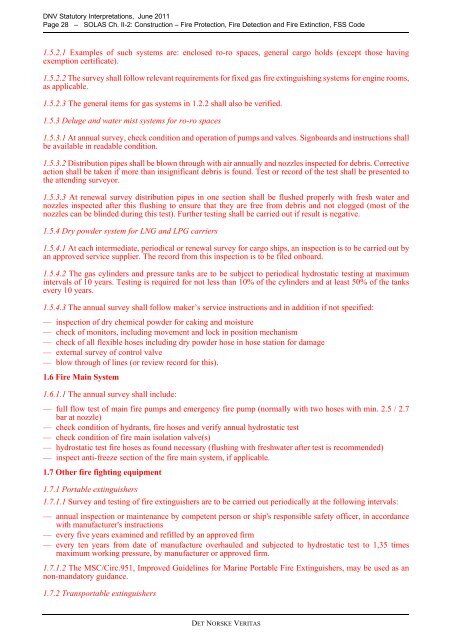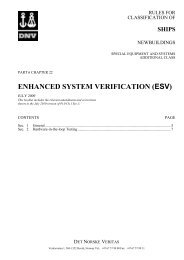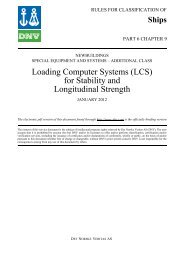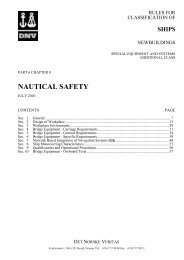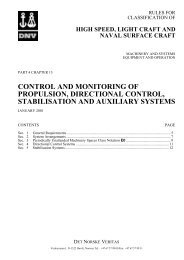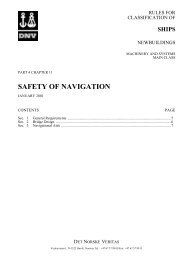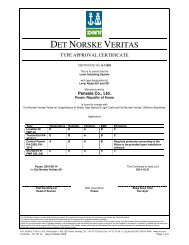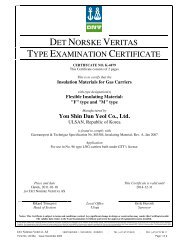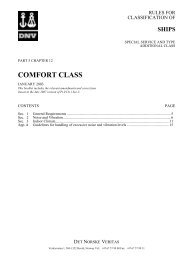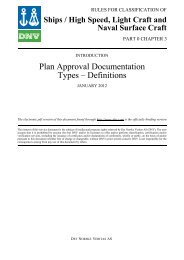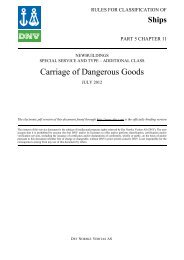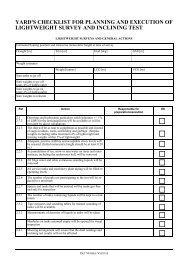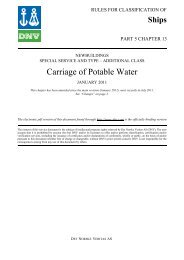solas interpretations - DNV Exchange
solas interpretations - DNV Exchange
solas interpretations - DNV Exchange
You also want an ePaper? Increase the reach of your titles
YUMPU automatically turns print PDFs into web optimized ePapers that Google loves.
<strong>DNV</strong> Statutory Interpretations, June 2011<br />
Page 28 – SOLAS Ch. II-2: Construction – Fire Protection, Fire Detection and Fire Extinction, FSS Code<br />
1.5.2.1 Examples of such systems are: enclosed ro-ro spaces, general cargo holds (except those having<br />
exemption certificate).<br />
1.5.2.2 The survey shall follow relevant requirements for fixed gas fire extinguishing systems for engine rooms,<br />
as applicable.<br />
1.5.2.3 The general items for gas systems in 1.2.2 shall also be verified.<br />
1.5.3 Deluge and water mist systems for ro-ro spaces<br />
1.5.3.1 At annual survey, check condition and operation of pumps and valves. Signboards and instructions shall<br />
be available in readable condition.<br />
1.5.3.2 Distribution pipes shall be blown through with air annually and nozzles inspected for debris. Corrective<br />
action shall be taken if more than insignificant debris is found. Test or record of the test shall be presented to<br />
the attending surveyor.<br />
1.5.3.3 At renewal survey distribution pipes in one section shall be flushed properly with fresh water and<br />
nozzles inspected after this flushing to ensure that they are free from debris and not clogged (most of the<br />
nozzles can be blinded during this test). Further testing shall be carried out if result is negative.<br />
1.5.4 Dry powder system for LNG and LPG carriers<br />
1.5.4.1 At each intermediate, periodical or renewal survey for cargo ships, an inspection is to be carried out by<br />
an approved service supplier. The record from this inspection is to be filed onboard.<br />
1.5.4.2 The gas cylinders and pressure tanks are to be subject to periodical hydrostatic testing at maximum<br />
intervals of 10 years. Testing is required for not less than 10% of the cylinders and at least 50% of the tanks<br />
every 10 years.<br />
1.5.4.3 The annual survey shall follow maker’s service instructions and in addition if not specified:<br />
— inspection of dry chemical powder for caking and moisture<br />
— check of monitors, including movement and lock in position mechanism<br />
— check of all flexible hoses including dry powder hose in hose station for damage<br />
— external survey of control valve<br />
— blow through of lines (or review record for this).<br />
1.6 Fire Main System<br />
1.6.1.1 The annual survey shall include:<br />
— full flow test of main fire pumps and emergency fire pump (normally with two hoses with min. 2.5 / 2.7<br />
bar at nozzle)<br />
— check condition of hydrants, fire hoses and verify annual hydrostatic test<br />
— check condition of fire main isolation valve(s)<br />
— hydrostatic test fire hoses as found necessary (flushing with freshwater after test is recommended)<br />
— inspect anti-freeze section of the fire main system, if applicable.<br />
1.7 Other fire fighting equipment<br />
1.7.1 Portable extinguishers<br />
1.7.1.1 Survey and testing of fire extinguishers are to be carried out periodically at the following intervals:<br />
— annual inspection or maintenance by competent person or ship's responsible safety officer, in accordance<br />
with manufacturer's instructions<br />
— every five years examined and refilled by an approved firm<br />
— every ten years from date of manufacture overhauled and subjected to hydrostatic test to 1,35 times<br />
maximum working pressure, by manufacturer or approved firm.<br />
1.7.1.2 The MSC/Circ.951, Improved Guidelines for Marine Portable Fire Extinguishers, may be used as an<br />
non-mandatory guidance.<br />
1.7.2 Transportable extinguishers<br />
DET NORSKE VERITAS


